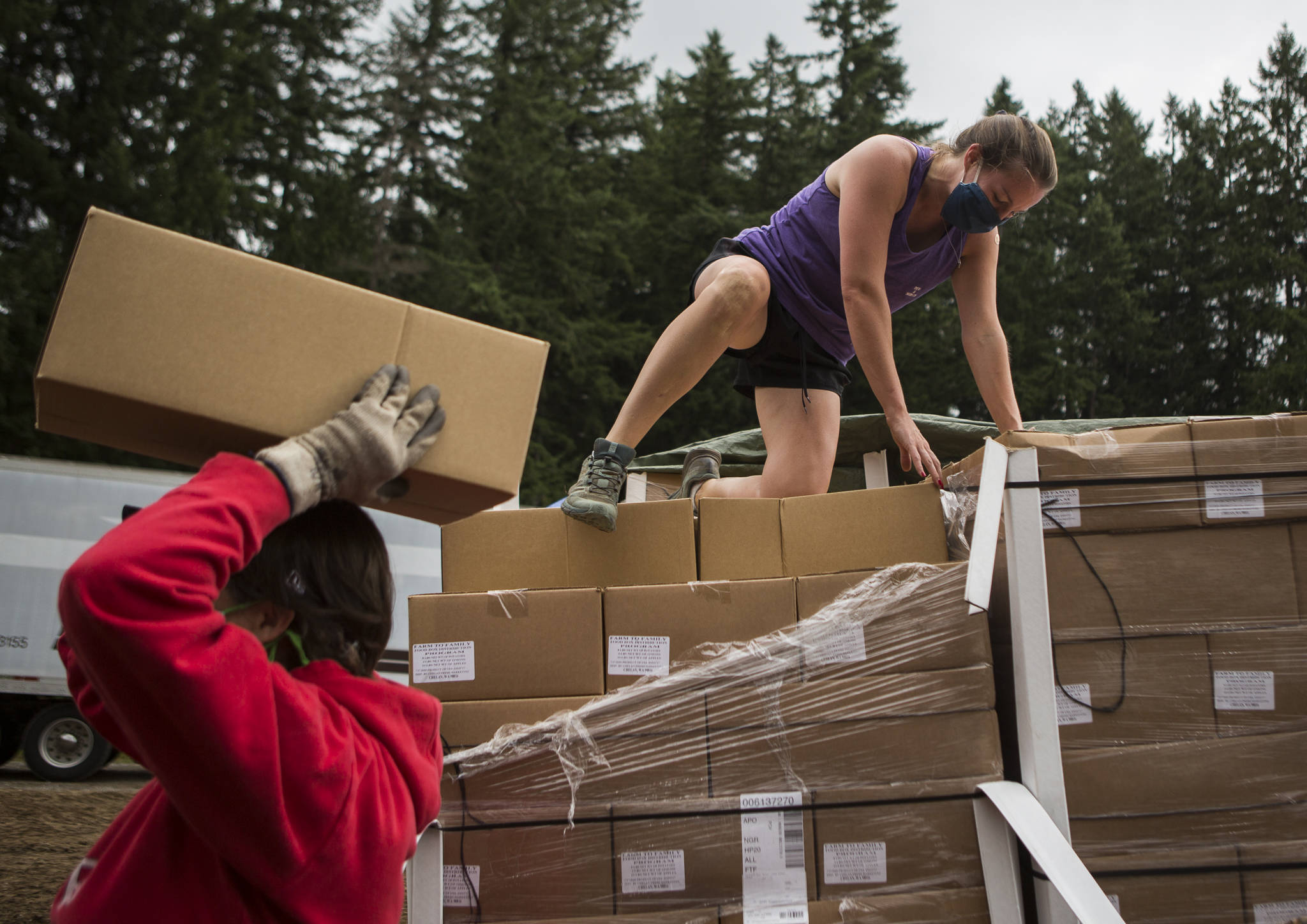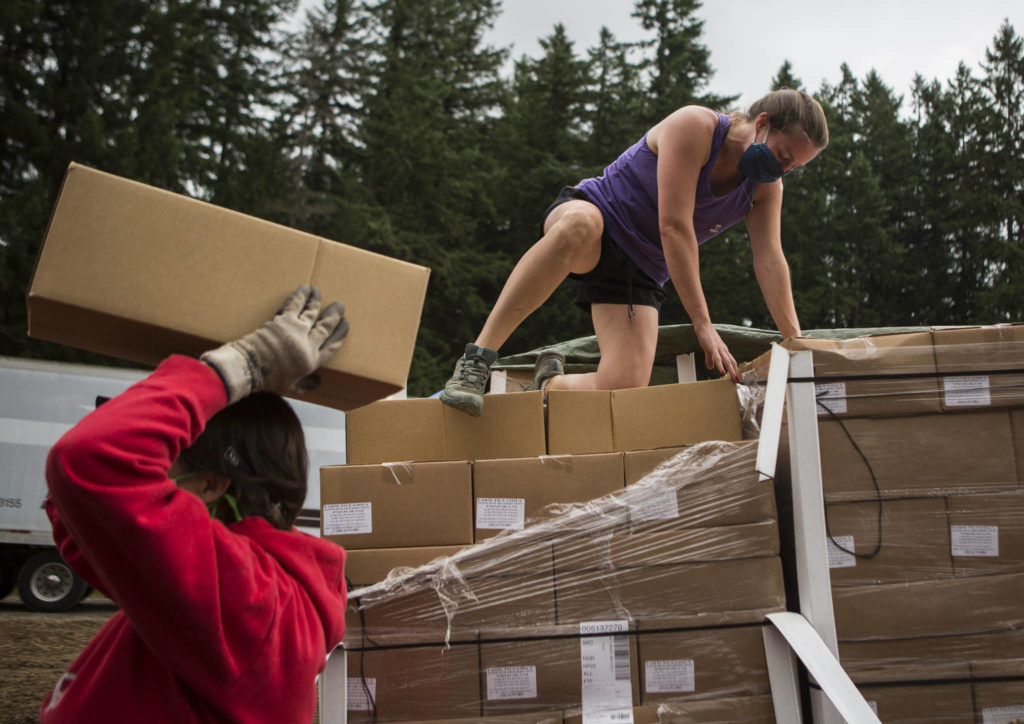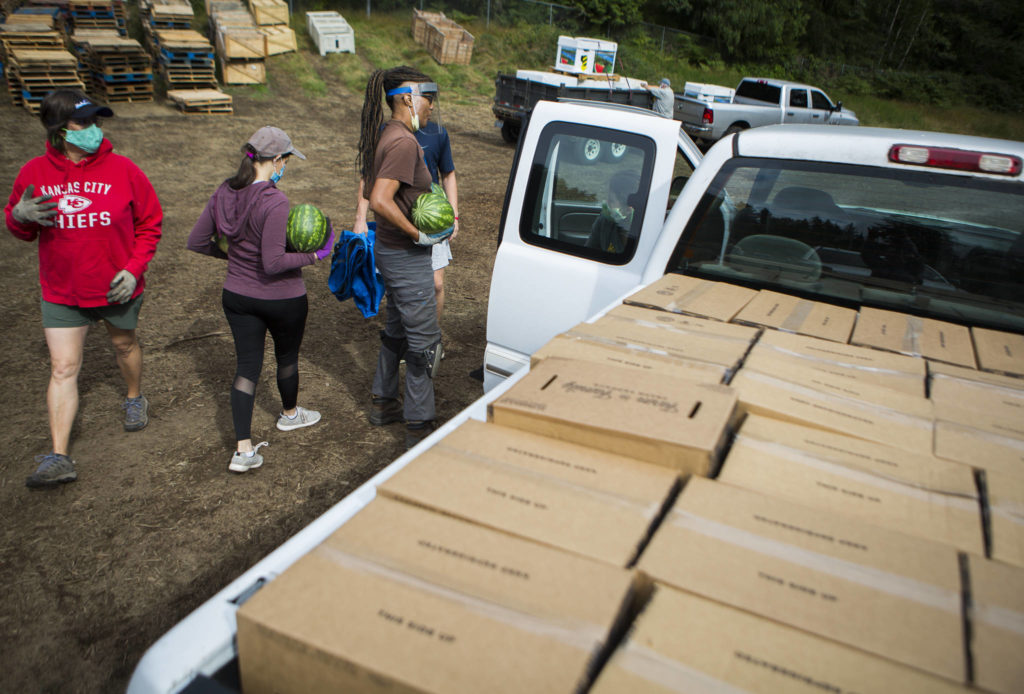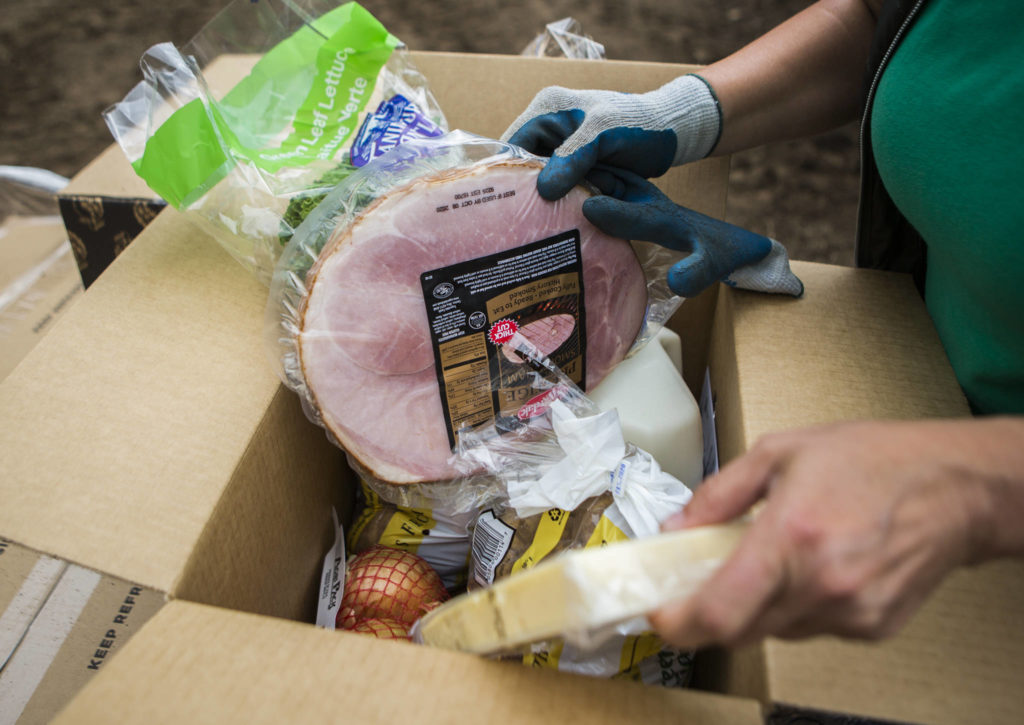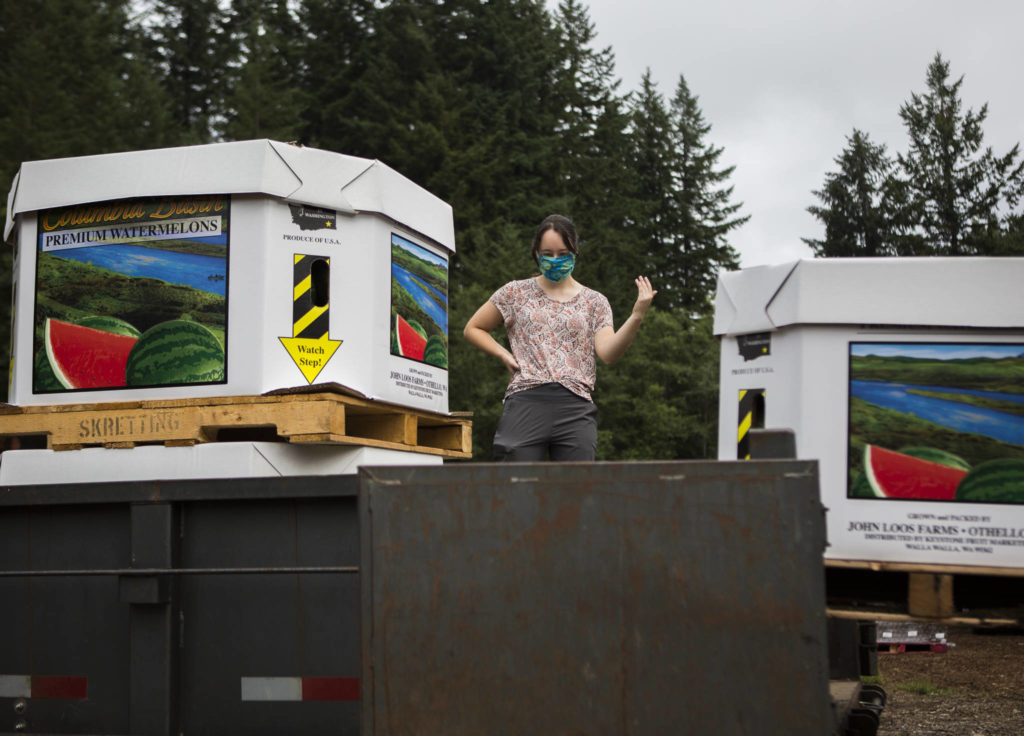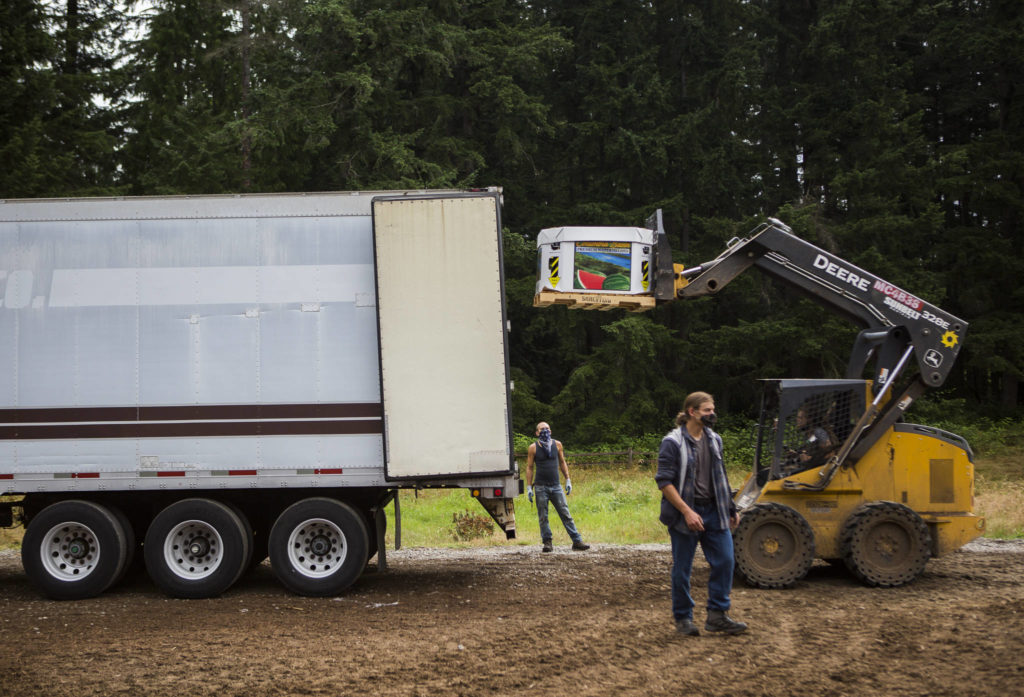WOODINVILLE — Pickup trucks and SUVs lined the driveway to a Woodinville farm last week, their drivers ready and waiting. When a semi-truck loaded with 48,000 pounds of produce, dairy and meat products, and another with nearly 50,000 pounds of watermelon arrived, they sprung into action.
Two Bobcats zipped from the open semis to pickup trucks and open trunks. Two hours later, the almost 100,000 pounds of food were en route to households, neighborhood groups, churches and food banks.
The scene is now an almost-daily occurrence at Farmer Frog, a working farm and nonprofit that helps start school gardens while teaching kids the science of growing food.
But with summer camps cancelled and schools closed, most of their programs are on hold.
“This is what we do now,” Farmer Frog founder Zsofia Pasztor said Friday, gesturing to the white boxes full of watermelon from a farm in Othello.
In the past three months, Pasztor and a host of other volunteers have distributed millions of pounds of food, much of it salvaged from farmers who lost sales due to COVID-19.
The operation, now a nonprofit called EastWest Food Rescue, started with a Facebook post back in late April.
Bothell resident George Ahearn read about farmers in his hometown of Othello preparing to till under potato crops after contracts for restaurants and schools suddenly vanished.
At the same time, Ahearn saw those around him struggle to get enough food on the table.
“I’m not a wealthy individual, but I felt like I was sitting in an ivory tower watching my neighbors and friends lose their jobs and businesses,” he said. “I got mad.”
So he reached out to Terra Gold Farms in Othello, where 20 million pounds of potatoes sat in storage unsold.
Most of the spuds were meant to go to processing plants and then to restaurants and school where they’d become french fries and hash browns.
Chief Operations Officer Austin Ochoa said the excess would likely have gone to cattle feed — at a total loss to the farm.
When Ahearn reached out, Terra Gold quickly offered to donate several thousand pounds of potatoes.
Once he had the food, Ahearn needed a place to store it, and then a means of transporting it to people in need. Again, he turned to Facebook, and his post caught Nancy Balin’s eye.
Balin lost her job due to COVID-19 in February, so she jumped at the chance to keep her hands busy.
“I had done nothing useful since February when all of my income had abruptly died and I had fixed everything I could around my house,” she said.
She had acreage to store the potatoes on, and a roommate with a trailer who could help transport.
Then, they needed crates to pack the potatoes.
Social media again made the connection to Farmer Frog, where Zsofia offered crates and the help of her staff.
The three ended up dumping 20,000 pounds of potatoes and onions at Farmer Frog.
By 7 p.m. that day, every spud was spoken for.
“I called George and said, ‘we need more,’” Pasztor said.
So Ahearn reached out to more farmers. Pasztor added Farmer Frog’s own produce to the mix. Processing plants and other nonprofits began offering food, and monetary donations started to pour in. One man even donated his stimulus check, Ahearn said.
At first, the three founding members called the operation East to West Food Rescue.
But that quickly changed as they realized help is needed in both directions.
“We’re not asking for free food,” Ahearn said. “We’re out here trying to put some money back into the farmers’ hands.’’
Since COVID-19 hit, Ochoa said potato processors have cut back on the acreage they source from by about 10%. It costs farmers $2,000 to $2,500 to plant an acre of potatoes, he said, so many are scaling back their crops for next year.
“That, to me, is the scariest thing in the world,” Ahearn said.
With less supply, he worries food prices will rise.
“We’re trying to encourage the farmers to plant more next year,” he said.
Since his first run May 1, Ahearn said the amount of food the group gathers and distributes each week has steadily grown.
The second week, they delivered 60 tons of food. The next, 90 tons.
“It’s just been every single week,” Ahearn said, and there’s no sign of the demand easing up.
Three months into EastWest Food Rescue, the founders estimate they’ve delivered over 3 million pounds of food to roughly 800,000 people. It’s gone everywhere from Portland to Forks and Blackfoot, Montana.
“This is what we’re supposed to be doing,” Richard Zambrano with the Northwest Tribal Emergency Management said as he loaded his 18-foot trailer. He planned to deliver that load to the Sauk-Suiattle, Stillaguamish and Tulalip Tribes.
To get the food they gather on to people’s plates, Zsofia said EastWest Food Rescue has worked with over 250 organizations, from food banks to neighborhood groups.
Few of the partnerships are formal.
“We literally are flying this plane while we’re building it,” Balin said.
At times, that looks like chaos. But distribution is carefully managed by a team of volunteers — many of them teens or young adults, and many of them women, Pasztor said.
Farmer Frog intern Emma Silber said she thinks that’s because it was tough to get a job or internship this summer.
The 19-year-old started working with Farmer Frog in June after her university sent students home early for the year.
On July 24, she circled stacked boxes of watermelon, clipboard in hand, shouting directions over engine noise.
“They realized I’m good at bossing people around,” Silber said. It’s earned her the role of assistant floor manager.
The spreadsheet on her clipboard details the food brought to the farm that morning, which she then directs to pick up depending on vehicle size.
As EastWest Food Rescue scales up, so does the demand.
That’s because the organization is filling a need that food banks can’t, Ahearn said.
Some people can’t make it to the food bank at a specific time to pick up food, he said. And those with green cards, or without, may avoid formal food services.
“We fill that gap,” Ahearn said.
But EastWest Food Rescue volunteers take the food wherever it’s needed — to churches, apartment buildings, nonprofits or individual households.
The organization has no full-time staff. The work gets done on lunch breaks, evenings and weekends, Balin said.
“The people who come here are some of the most selfless people I’ve ever met,” Silber said. “They’ll travel for hours to bring food to people they don’t know.”
Dawn Montemoiño, a Farmer Frog intern and Veterans Conservation Corps member, likens the work to her time in Afghanistan.
“Here, it’s food coming to the front line,” Montemoiño said. “Every time I put another box on the stack, I’m defending what I love.”
As the days get warmer, Pasztor said they need to get refrigerated storage on site. They have one 36-foot trailer at the farm supplied by Snohomish County, but need more capacity to keep dairy and fresh produce from going bad before it reaches plates.
They need infrastructure, and the funding to build it, Balin said.
“Our hugest worry is that we haven’t even seen the food shortages that are coming,” she said. “The need is not going away.”
Julia-Grace Sanders: 425-339-3439; jgsanders@heraldnet.com.
Talk to us
> Give us your news tips.
> Send us a letter to the editor.
> More Herald contact information.
